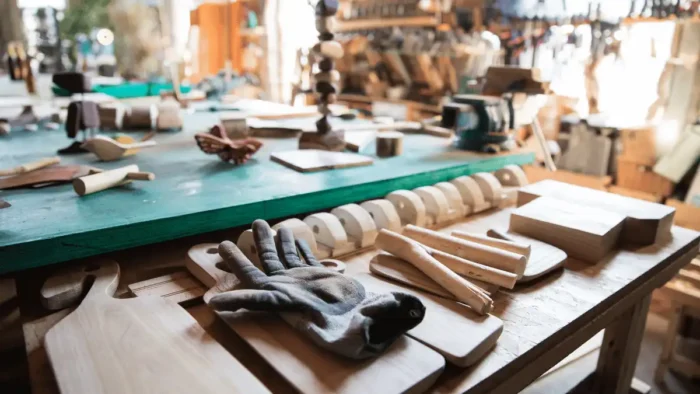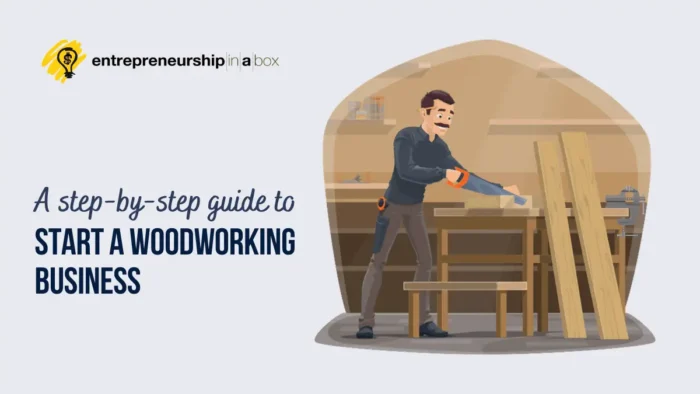Imagine a world where your love for woodworking evolves into a lucrative business, where every sawdust particle brings you closer to your entrepreneurial dream. This isn’t just a dream. It’s a reality waiting to unfold!
The journey from a woodworking enthusiast to a thriving new business owner may seem daunting, but it’s entirely within reach with determination, skill, and the right guidance. Get ready to navigate the ins and outs of starting a woodworking business, one step at a time.
Key Takeaways
- Craft your business vision by identifying a woodworking niche and setting achievable goals.
- Create a strong legal foundation, invest in quality tools & equipment, and explore funding options for financial success.
- Develop an online presence, establish fair pricing for creations, build a skilled team & craft your brand identity to maximize success!
The State of the Woodworking Industry
Environmental regulations have a significant impact on this industry. With increasing awareness about sustainable practices, companies must comply with strict environmental regulations. This could increase operational costs and allow companies to distinguish themselves through environmentally friendly practices.
The cost of materials is another factor affecting woodworking businesses. Any changes in the prices of raw materials can directly impact the cost of production, which in turn affects the pricing of the finished products. So, woodworking businesses must strategically manage their resources and supply chains to mitigate these risks.
To stay competitive, woodworking businesses should also consider investing in innovative technologies to increase efficiency and reduce costs. Furthermore, given the growing importance of sustainability, small businesses that incorporate eco-friendly practices into their operations could potentially gain a competitive edge in the market.
Craft Your Business Plan

Your journey toward establishing a woodworking business begins with defining a clear vision and careful planning. Having a clear vision is your compass, guiding you through many business decisions. It’s the foundation stone upon which the castle of your woodworking business will stand.
Identifying your woodworking niche and setting achievable goals are the two pillars of your business plan. Remember that pinpointing a niche can direct small woodworking businesses toward operational success.
So, are you ready to carve out your niche in the woodworking niche and start your own small business?
Related: Guide to Starting a Senior Living Facility or Assisted Living Facility for Entrepreneurs
Identify Your Woodworking Niche Business Model
Entering the woodworking business world mirrors the exploration of a forest. Numerous paths diverge, each leading to a unique destination and niche. Identifying your woodworking niche is similar to choosing your path in this forest.
Woodworking businesses can cover anything from building custom furniture through crafting sophisticated rocking chairs for adults aged 30-60 to specializing in valuable skills such as restoration and repairs.
Some examples of woodworking business models you can choose are the following:
1. Custom Furniture Design and Creation
- Initial Costs: This business requires a substantial initial investment for a workshop, woodworking machinery, and raw materials. Costs can range from $10,000 to $50,000.
- Equipment/Materials: Essential equipment includes table saws, band saws, routers, sanders, and various hand tools. The primary material is wood.
- Revenue Potential: Depending on the quality and uniqueness of the furniture, prices can range from hundreds to thousands of dollars per piece.
- Market Demand: There’s a growing demand for unique, high-quality wood furniture that reflects individual style.
2. Hand-Carved Wooden Home Decor
- Initial Costs: Startup costs are relatively low, ranging from $1,000 to $5,000 for carving tools and raw materials.
- Equipment/Materials: Carving tools, finishes, and various types of wood are needed.
- Revenue Potential: Prices depend on the complexity and uniqueness of the designs, ranging from $20 to several hundred dollars.
- Market Demand: Hand-carved items have a niche market, with customers appreciating the craftsmanship and unique designs.
3. Wooden Toy Manufacturing
- Initial Costs: Costs range from $5,000 to $15,000 for machinery, safety certifications, and raw materials.
- Equipment/Materials: Cutting tools, sanders, finishes, and wood are required. Safety is paramount, so non-toxic materials are essential.
- Revenue Potential: Prices can range from $10 to $100 or more depending on the toy’s size and complexity.
- Market Demand: With concerns about plastic waste and safety, there’s a growing interest in wooden toys.
4. Luxury Wooden Watches
- Initial Costs: Startup costs can be significant, ranging from $10,000 to $50,000 for machinery, materials, and branding.
- Equipment/Materials: Precision tools, high-quality wood, watch components, and finishes are required.
- Revenue Potential: Luxury wooden watches can retail from $100 to $500 or more.
- Market Demand: Wooden watches have become a fashion statement due to their uniqueness and sustainability appeal.
5. Wooden Cabinetry and Kitchen Remodeling
- Initial Costs: Startup costs can range from $10,000 to $100,000 for a workshop, tools, and materials.
- Equipment/Materials: Tools, various types of wood, finishes, and hardware are needed.
- Revenue Potential: Depending on the project’s size and complexity, prices can range from a few thousand to tens of thousands of dollars.
- Market Demand: The demand for kitchen remodeling and custom cabinets is steady, with homeowners often looking to update their kitchens.
6. Wooden Flooring Installation and Repair
- Initial Costs: Costs range from $10,000 to $25,000 for tools, transportation, and initial supplies.
- Equipment/Materials: Flooring tools, various types of wood flooring, finishes, and repair materials are needed.
- Revenue Potential: Depending on the project’s size, prices can range from a few hundred to several thousand dollars.
- Market Demand: Wooden flooring remains popular for its durability and aesthetic appeal, and there’s continuous demand for installation and repair services
Find your path, tailor your woodworking undertakings to meet your target audience’s unique preferences and demands, and watch your small business grow into a successful woodworking business with a strong woodworking business brand. As woodworking business owners, staying focused on goals and adapting to the changing market requirements is essential. A well-designed woodworking business website can help you achieve these goals and connect with your target audience.
Related: 9 Steps to Start a Charity
Set Up Business Goals
As you probably know, small businesses need to have clear goals.
Establishing business goals for your woodworking enterprise can be compared to engraving intricate patterns into wood. Each goal is a pattern, a step towards creating a masterpiece. Setting SMART (Specific, Measurable, Achievable, Relevant, Time-bound) goals can drive your business forward.
Legal Foundations for Your Woodworking Endeavor

Like every woodworking project that requires a blueprint, your woodworking business needs a similar legal framework – a structure that gives it legal recognition and safeguards it from potential liabilities.
Next, you must open a business bank account for your own business so you can protect your personal assets from any business debts and liabilities.
Remember that most companies must collect sales tax, so understanding the sales tax requirements and obtaining all necessary licenses and permits will ensure you’re not leaving money on the table and avoid legal issues. Remember, finishing all legal paperwork is as important as laying the foundation for your workshop.
Select the Right Legal Business Entity
Choosing the appropriate business entity for your small woodworking business aligns with selecting the best wood for your project. As with any other business, you must select the right business entity, such as:
- sole proprietorship
- LLC (limited liability corporation)
- partnership
- corporation
All of them have unique characteristics and benefits.
An LLC, for instance, provides personal liability protection and pass-through taxation benefits, which are crucial for protecting your business and maximizing your financial advantages. Therefore, consider the unique properties and benefits of each entity, and choose the one that best suits your business needs.
Related: Choosing the Right Legal Structure for Your Business: A Comprehensive Guide
Navigating Business Licenses and Permits
Similar to requiring permits for felling certain trees, your woodworking business needs specific licenses and permits for its operation, including a business license. By ensuring you have the essential licenses and permits, you can avoid possible fines and ensure the smooth operation of your business.
Always remember, in the woodworking business, following the rules is just as important as following your passion.
Financial Blueprint for Successful Woodworking Business

The specifics of your financial blueprint determine your business’s financial health. Crafting a budget and finding funding are two crucial pieces of this blueprint.
A clear and detailed budget will help you control your finances while exploring funding options ensures you have the financial resources to support and grow your business.
Crafting a Budget for Your Own Woodworking Business
In woodworking, each timber piece holds value, and in business, each cent is significant. Crafting a budget for your woodworking business is like measuring and cutting your wood pieces accurately. It involves determining the startup costs for tools, equipment, and workspace, estimating ongoing expenses, and calculating expected revenue.
By having a clear budget, you ensure that you cut no corners in financial planning.
Funding Options for Woodworkers
Like various woodworking tasks needing different wood types, different business stages call for varied funding types. Whether it’s self-funding, loans, or attracting investors, each option has its own pros and cons.
Understanding these options will help you select the most suitable funding source for your woodworking business.
Related: 13 Failproof Ways to Raise Money Fast for Your Startup
The Woodworker’s Workshop: Setting Up Shop

Establishing your woodworking shop involves several important decisions and steps, including:
- Choosing the right location for your woodworking shop
- Acquiring essential tools and equipment
- Organizing your workspace layout for maximum efficiency, productivity, and safety
- Setting up proper lighting and ventilation
- Creating storage solutions for your materials, supplies, and finished goods
- Personalizing your workshop to reflect your style and creativity
Your choice shapes your workshop into a space where creativity meets business.
Choosing a Location for Successful Business
As a small business owner, you must find a suitable location for your woodworking workshop. It is important and similar to picking the perfect wood piece for your project. It needs to be just right. Your workshop should have adequate space to house power tools and machinery and allow easy movement. It should also be accessible for customers and deliveries and comply with noise regulations.
Remember, the location of your small business can significantly impact your operational costs and the success of your business.
Essential Tools and Equipment
When you start a woodworking business, selecting tools can either enhance or limit your project. So, investing in the right tools and equipment is crucial for developing your woodworking skills. Some essential tools for woodworking include:
- Table saws for large cuts
- Chisels for precision work
- Miter saws for angled cuts
- Router for shaping and creating decorative edges
- Drill press for accurate drilling
- Sanders for smoothing surfaces
- Clamps for holding pieces together
- Tape measure for precise measurements
Each tool plays a vital role in your craft that can ensure your business stand out from competitors.
Remember, quality tools not only guarantee top-notch work but also enhance the efficiency and productivity of your business.
Marketing Woodworks: Strategies to Reach Your Audience

As you display your woodworking products at a craft fair, you must present your business to your target audience. Effective marketing strategies, both online and offline, can help you reach your potential customers, promote your business, and build a strong brand.
Developing an Online Presence
Maintaining a robust online presence is as crucial as possessing the appropriate tools in your workshop in the digital age. A robust online marketing, through a website and social media platforms, creates a powerful platform where customers can learn about your business, view your products, and purchase. For example, you can use the Facebook marketplace to reach a more larger target market for your woodworking jobs.
You can see that many business owners underestimate the importance of online presence. So, remember, your online presence reflects your brand, so make sure it resonates with your target audience.
Related: Internet Marketing Objectives For Your Business Online Presence
Offline Marketing Techniques
Though digital marketing is essential, the influence of traditional marketing methods should not be underestimated. From networking to print materials and local events, offline marketing techniques can effectively promote your woodworking business in your local community.
Remember, an effective marketing strategy uses a combination of online and offline techniques to reach a wider audience.
Related: 10 Unique Ways to Advertise Your Business and Stand Out
Build a Strong Brand Identity
As every woodwork piece you create mirrors your skills and creativity, your brand identity embodies your business’s values and style. Each aspect contributes to building a unique and memorable brand identity, from choosing your business name and designing your business logo to sharing your brand narrative.
Your woodworking business name must be simple, reflect the quality and creativity of your product, and should appeal to your target audience.
Your business logo can be likened to your signature on your woodwork. It’s a symbol of your brand identity. A visually appealing logo and marketing materials can represent your business’s values and style and make a strong impression on your customers.
Remember, your brand narrative conveys your business’s story. Sharing your business’s story on your woodworking blog can connect with your audience on an emotional level, build brand loyalty, and set your business apart from competitors.
Sales and Profitability: Pricing and Selling Your Creations
As every woodwork piece you create holds a price, each business aspect contributes to its profitability. Understanding how to price your creations and finding the best sales channels are crucial to the success of your woodworking business.
Establish Fair Pricing
The process of pricing your woodworking creations involves considering several factors to establish a fair price. Here are some factors to consider:
- Competitive pricing,
- Quality of work,
- Material costs involved,
- Cost of labor,
- Overhead costs, and
- Desired profit margins
By taking these factors into account, you can determine a price that is fair to both you and your customers.
Related: Your Ultimate Pricing Guide: 10 Steps for Price Setting for Your Products
Find the Best Sales Channels
Different sales channels can be used for different customer types. Whether it’s online platforms like Etsy and Craigslist, local stores, or custom orders, each sales channel has its unique advantages.
Managing Your Woodworking Company
Transitioning from a woodworker to a business owner entails assuming multiple roles. You must be eager to learn from other business owners and their experience. From customer service and inventory management to building a skilled team, each aspect requires your attention and management skills.
Customer Service Excellence
In the woodworking business, your customers are your patrons. Providing excellent customer service can help you build a positive reputation, attract more customers, and increase customer loyalty. Remember, satisfied customers are the best advertisement for your business.
Inventory and Supply Chain Management
Just as you organize your tools and wood pieces in your workshop, you need to manage your inventory and supply chain in your business. Effective inventory management can ensure smooth operations, while efficient supply chain management can minimize costs and maximize profits.
Build a Skilled Team
Just as every tool in your workshop has a specific purpose, every member of your team has a unique role. Hiring employees and building a skilled team involves recruiting the right people, providing them with the necessary training, and creating a supportive and collaborative work environment.
Protect Your Craft: Woodworking Business Insurance and Liability
Many small business owners underestimate the protection of their new business.
As you use safety equipment for personal protection during work, your business likewise needs insurance coverage. Getting appropriate insurance coverage and understanding liability concerns are crucial to protecting your business from potential risks and liabilities.
Summary
From a business idea to starting and growing a woodworking brand, each step on your journey to starting a woodworking business brings you closer to transforming your passion into a profitable venture. Remember, your success as a business owner lies in your hands, just like the wood you shape into beautiful creations.
Frequently Asked Questions
Woodworking is a highly profitable business, with demand for custom, hand-crafted furniture and other goods growing exponentially. With the right niche and quality products, marketing and selling can lead to lucrative outcomes and very successful business. Starting a woodworking business could be incredibly rewarding. How much profit it will make will be based on the type of the business and target market size.
Starting a woodworking business requires an average investment of $1,000 to $50,000. It all depends on the business model you choose and the quality of tools and materials you need to set up your shop. Invest wisely and get started on your journey to success!
Start your woodworking journey by educating yourself on fundamentals and techniques, equipping yourself with essential tools and equipment, and beginning with small projects.
Woodworking projects such as wooden signs, pallets, kitchen products, furniture, surfboards, boxes, picture frames, and children’s blocks are highly profitable and continue to sell well.





